Want to leave your company? In this quick guide, we’ll show you how to craft a professional two-week notice email or letter. We’ll also share a proven template to kickstart your writing process. Use these resources to resign with style and maintain amicable relationships with your employer.
That’s it. You’ve made your decision. You’re going to quit your job to pursue new opportunities. What an exciting time this is!
But before anything else, you should send your current employer a two-week notice letter or a formal resignation email.
Don’t quite know where to start? Don’t worry, we’ve got you covered. In this quick guide we’ll show you ⤵️
- What is a two weeks’ notice?
- Why give a two-week notice?
- How to write a two weeks notice email
- Two-week notice email template
- Tips for writing a professional two-week notice
Sounds good? Then let’s dive in.
What is a two weeks’ notice?
A two week’s notice is a formal letter (or email) sent by an employee to their supervisor or their employer.
The goal of this communication is to indicate your intention to resign from your current position, effective two weeks from the date of the notice.
Technically speaking, providing two week’s notice is not a legal obligation. But it’s considered a standard professional courtesy in most industries.
The expected notice period may vary depending on your role, level of responsibility, and the terms of your employment contract.
Why give a two-week notice?
Giving a two-week notice helps you leave your current job like a professionalmake a professional exit from your current job, which benefits both you and your employer. Here’s why ⤵️
- Professional courtesy – Giving two week’s notice is a standard practice that follows proper etiquette and shows respect for your employer.
- Smooth transition* – Your employer can use this time to start looking for a suitable replacement or to redistribute your workload.
- Networking opportunities* – Providing two week’s notice helps maintain relationships with your supervisor and colleagues.
- Positive reputation* – Leaving your job responsibly contributes to a good reputation in your industry and can lead to positive recommendations.
- Legal obligations* – Some companies require a notice period. Failing to comply with their terms can have consequences, such as forfeiting severance.
- Potential rehire* – If you leave a company on good terms, you’re more likely to be considered for rehire in the future should your career path lead you back.
How to write a two weeks notice email
Writing a two-week notice email or letter may seem like a daunting task at first. But it doesn’t have to be.
After speaking with dozens of HR professionals, we came up with a simple yet powerful formula to write this type of email.
Follow the 10 steps below to write a stellar notice of resignation almost effortlessly. If you’re in a rush, you can also steal this template from us.
1. Write a clear subject line
Begin your notice of resignation email with a clear subject line. You need to catch the attention of your employer and make them want to read your email.
The best way to do that is to be very transparent about the content of your email, by using keywords such as “resignation” or “two-week notice”.
Try to be concise. Ideally, your subject line should be less than 50 characters. Otherwise, it may be truncated on mobile devices.
Here are some of our favorite subject lines to start writing a two-week notice message. Feel free to use them in your email:
- Final day at [Company]
- Notice of resignation
- Leaving [Company]
- Two weeks notice
- Stepping down

2. Personalize your greeting
To add a human touch to your email, make sure to personalize your greeting by using your recipient’s name.
The best greeting for your two-week notice email will depend on your relationship with your employer and the company’s culture:
- If you have a formal relationship with your superior, use a traditional greeting and their last name, such as “Dear Mr. Doe”.
- If you’re close to your manager, you can use a friendly salutation and their first name, like “Hi John”.
- If you’re not sure how to address your supervisor, stick to a formal email opener and their first name, such as “Dear John”.

3. State your resignation
State your purpose directly in the first sentence of your email. Don’t leave any room for interpretation. Clearly express your intention to resign and indicate your job title and the name of your company.
This opening statement should remove any ambiguity about the purpose of your email and allow your recipient to prepare for the content that follows. Regardless of your reasons for leaving, make sure to maintain a professional tone.
Here’s an example of a good opening statement for your two-week notice email: ”I am writing to formally announce my resignation from my position as [Position] at [Company]”.
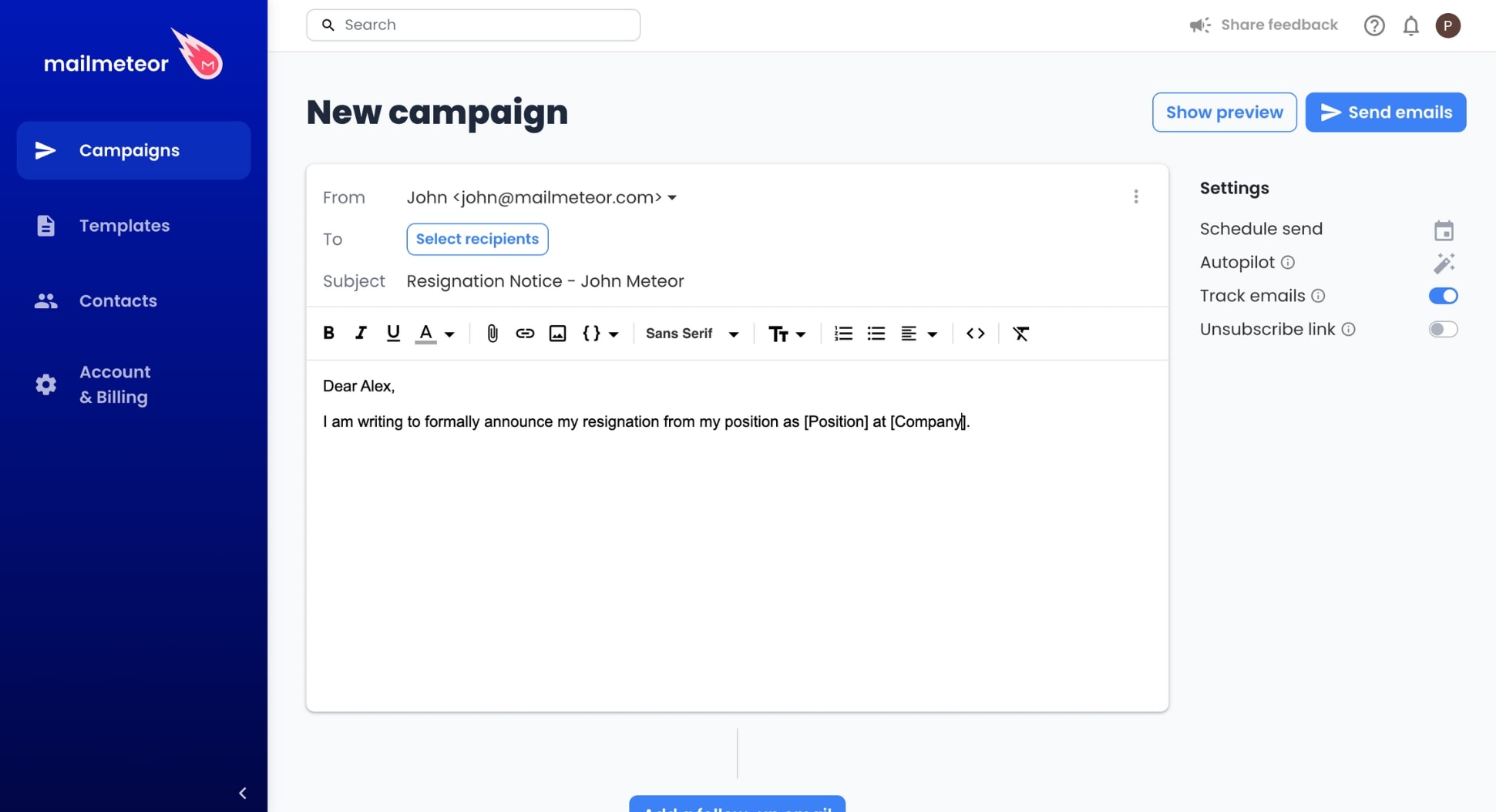
4. Specify your last day
Make sure to clearly mention your last day of work. Pick a date that is (at least) two weeks from now. Unless you have an emergency, in which case you may need to explain to your employer why you must leave without two weeks’ notice.
In certain companies, your notice period may be longer than two weeks. So take some time to check the terms of your contract of employment and the company policy before sending your resignation email.
If for some reason you can’t give the employer two week’s notice, try to notify them as soon as you can. They’ll need this time to redistribute your workload without disrupting the company’s activity.
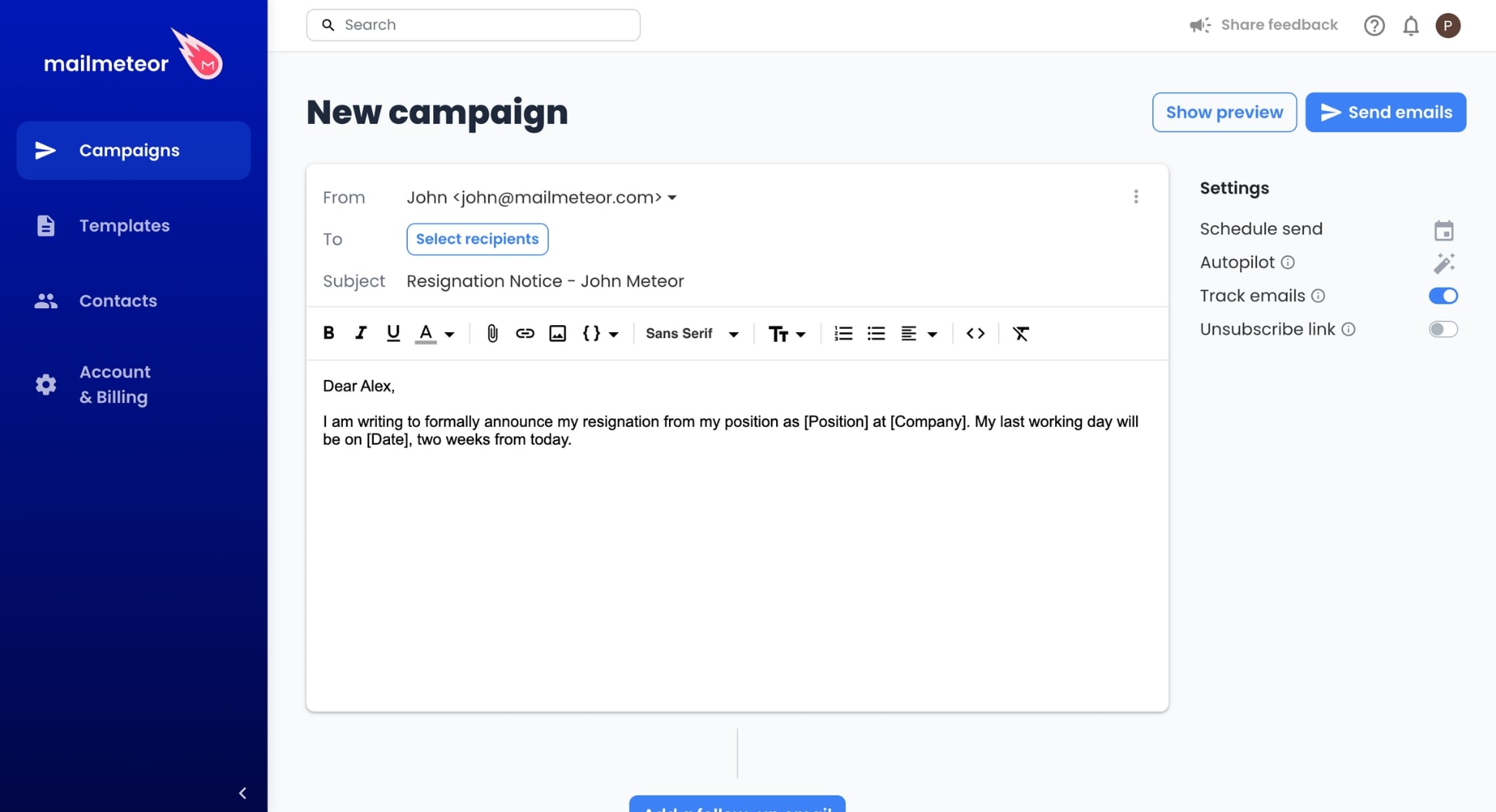
5. Show your gratitude
Briefly express your appreciation for the opportunities you’ve had during your time at the company. This can help you leave a positive impression and foster a sense of goodwill. It also reflects well on your character and professionalism.
However, make sure to be genuine and avoid over-exaggeration or generic statements, as they may come off as insincere. Here are some aspects that you might feel grateful about:
- Growth opportunities – Highlight positive experiences, such as professional development courses, challenging projects, or mentorship experiences.
- Work relationships – Express your gratitude for the company’s collaborative environment, the support you’ve received, or the relationships you’ve built.
- Specific achievements – You can also mention some specific projects that were particularly meaningful or rewarding.
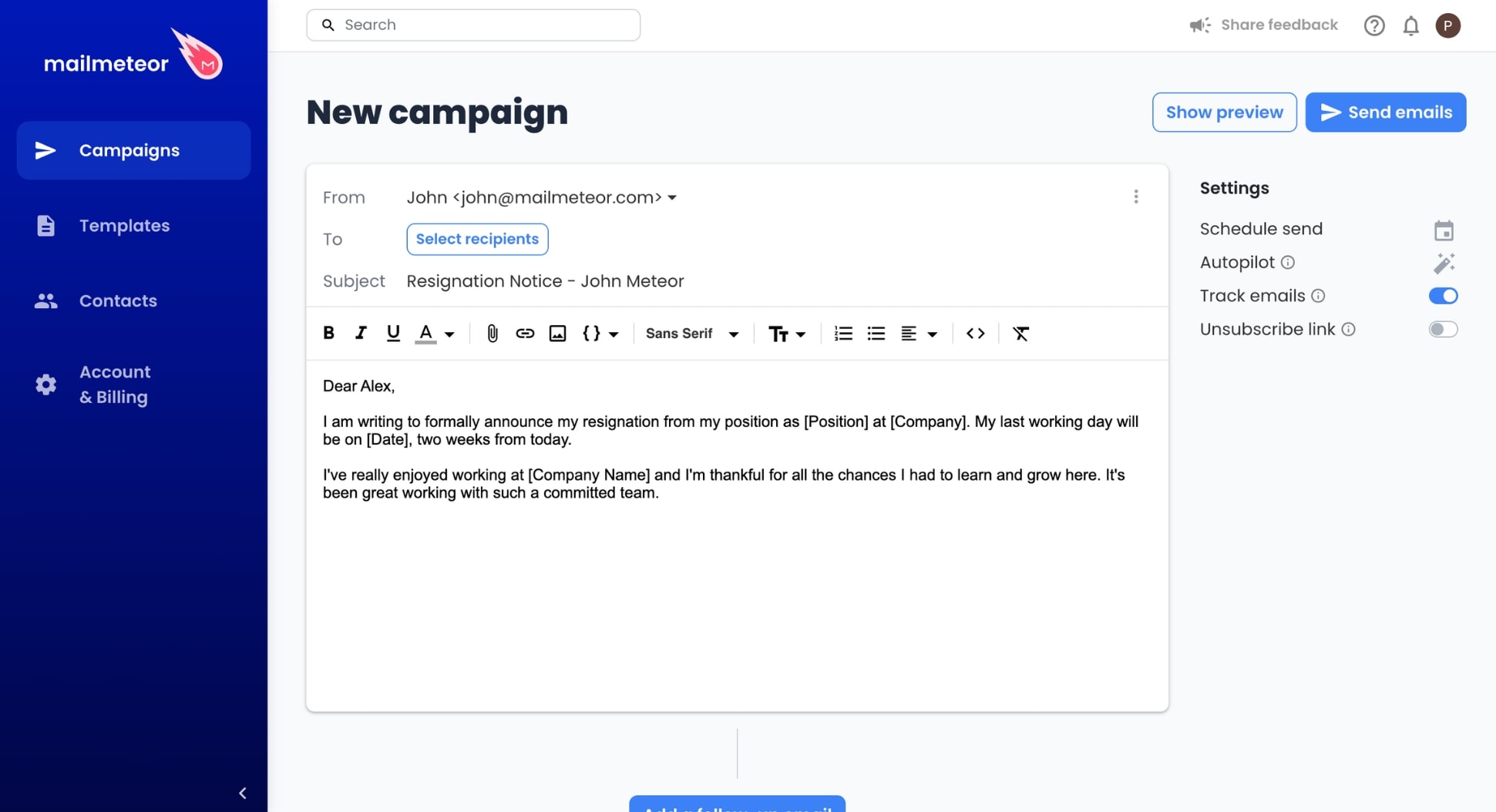
6. Offer your help
The best way to leave your job on good terms is to offer to assist in the transition after submitting your two-week notice.
This shows that you’re committed to ensuring that your departure does not negatively impact your team or the company.
Here are a few examples of how you can offer assistance in your notice of resignation email:
- Training your replacement – Offer to train your replacement (if there is one) to help them understand their new role and get up to speed.
- Document your tasks – Prepare detailed documentation of your tasks, processes, and ongoing projects.
- Handover your projects – Work with your manager and your team to redistribute your workload effectively.
- Share information – Provide passwords and access rights where appropriate, following your company’s security protocols.
- Offer feedback – Based on your experience, share soe constructive feedback on how processes could be improved.

7. Plan for the next steps
Make sure to include any HR-related questions that you may still have before leaving the company. For example, you could ask your employer:
- When will I receive my final paycheck?
- Will it include payment for unused vacation or sick leave?
- Is there a checklist of tasks I need to complete before I leave?
- How long will my health insurance remain active after my last day?
- What company property do I need to return and how should I return it?
- Will there be an exit interview and if so, how will it be conducted?
This is also a good time to ask about your obligations regarding any confidentiality or non-compete agreements you may have signed.
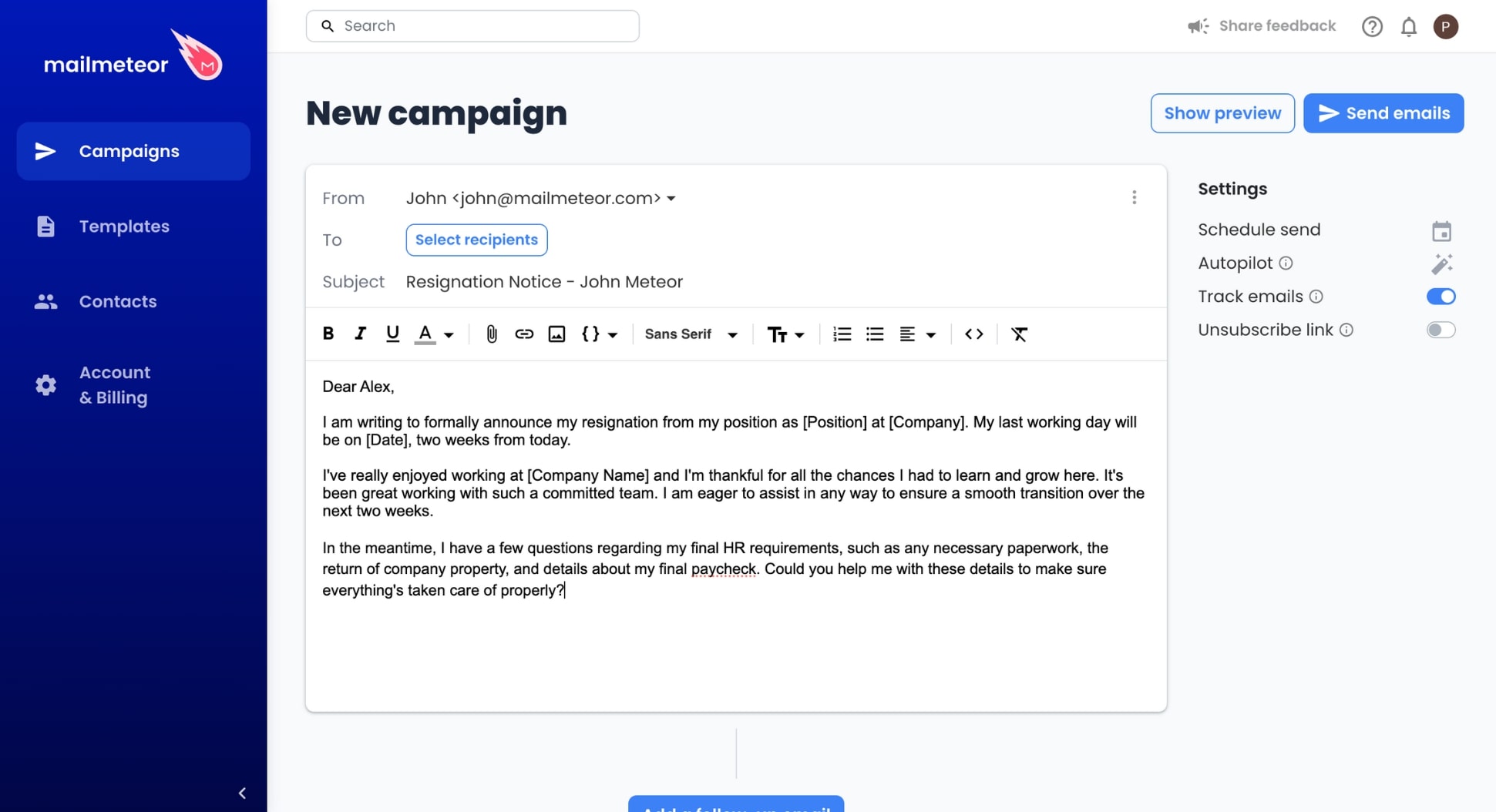
8. Sign off your email
End your resignation notice with a professional email sign-off. There are dozens of options for you to choose from:
- Warm regards,
- Kind regards,
- Best wishes,
- Sincerely,
Just make sure to stick to something formal and avoid overly familiar email sign-offs, such as “e” or “See ya”.
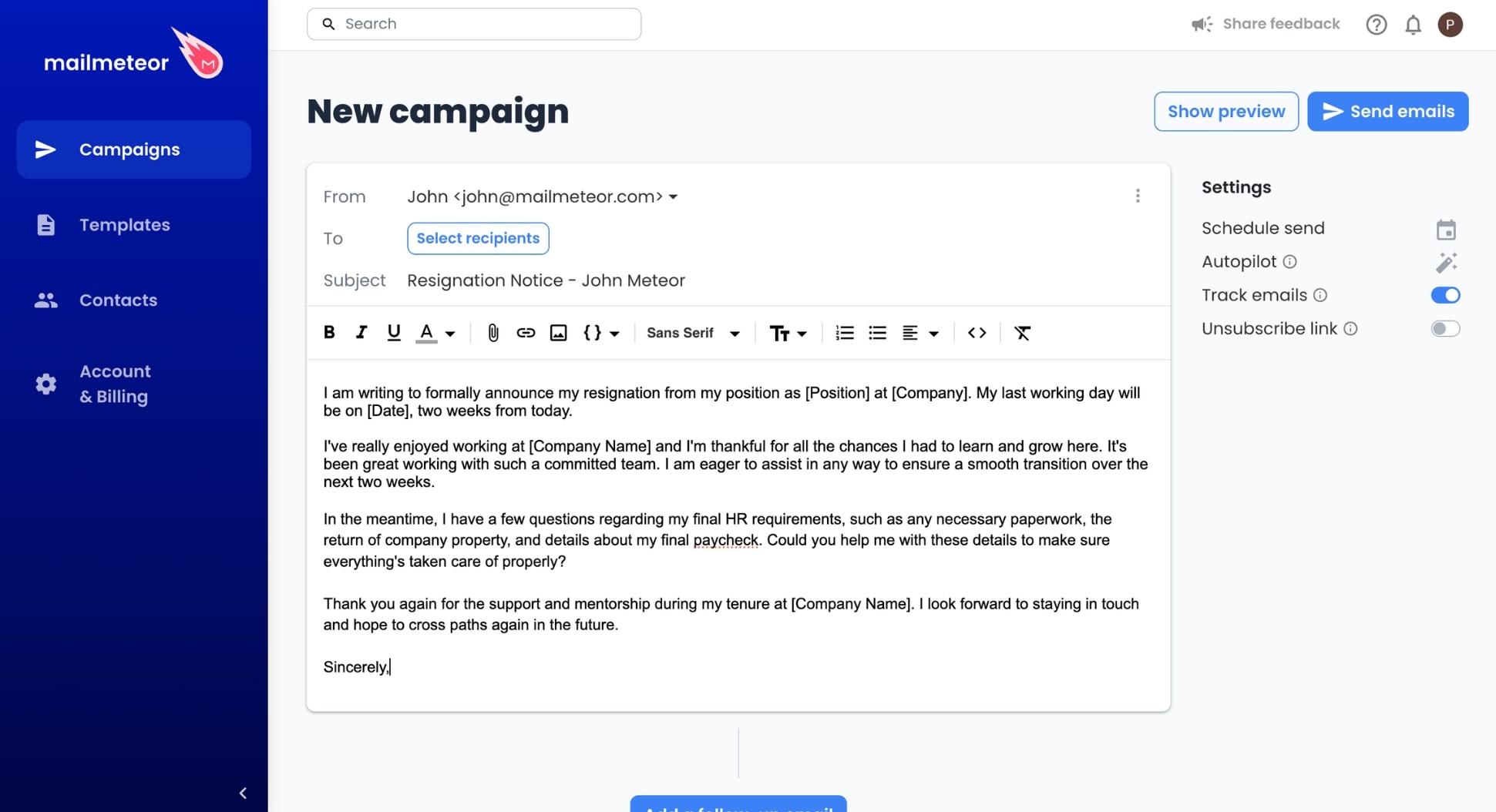
9. Add your signature
Finish your two-week notice message by including your email signature. Make sure to include your full name, as well as your contact details.
This includes your job title, the name of your company, your phone number, your email, and ideally, your profile picture.

10. Proofread your email
Last but not least, make sure to proofread your two-week notice email before sending it to your employer.
Hunt down any typos and grammatical missteps with a little help from spell-checking tools, like Quilbot or Grammarly.
You can also read your email out loud to see if your writing flows well, or send it to a friend to ask for a second opinion.
Two-week notice email template
Need some inspiration? Here’s a ready-made two week’s notice email template that you can use to resign from your current position. Feel free to use this sample to kickstart your writing process.
Dear [Name],
I hope this message finds you well. After much consideration, I have decided to resign from my position as [Job Title], with my last working day being two weeks from today, on [Date].
I appreciate the opportunities for professional development that you have provided me during my time at [Company Name]. It has been a pleasure contributing to our projects and learning from everyone.
Please let me know how I can assist in the transition process over the next two weeks. I am willing to help train my replacement or document my current projects to ensure a smooth handover.
Thank you for the support and guidance during my tenure with the company. I wish [Company] continued success in the future.
Kind regards,
[Your Signature]
Tips for writing a professional two-week notice
Want to make sure your two-week notice hits its mark? Here are a few extra tips to finetune your resignation message.
- Avoid negativity – Even if you’re leaving under bad circumstances, refrain from criticizing the company or your colleagues.
- Be concise – Keep your notice short and to-the-point. You don’t need to explain in detail why you’re leaving the company.
- Stay polite – Even if your relationship with your supervisor is tense, be respectful and maintain a courteous tone.
- Be prepared for immediate departure** – In some cases, employers may prefer that you leave immediately after giving notice. Be prepared for this possibility by organizing your personal items and work files.
- Know your rights – Take some time to read the company’s resignation policy and learn about your rights regarding final paychecks, accrued vacation time, and any other compensations due to you upon leaving.
- Say goodbye – Before leaving the company, make sure to send a goodbye email to your coworkers.
Conclusion
Giving two weeks’ notice to your employer sets the stage for a successful departure and ensures a smooth transition out of your current role. It’s a simple yet powerful way to foster goodwill, maintain relationships with your employers, and strenghten your professional reputation.
Writing a two-week notice email may seem like a chore. But with the step-by-step method we’ve covered in this guide, it should be a breeze. Remember to clearly state your intention to resign, specify your date of departure, express gratitude, and offer assistance during the transition.
Keep your message brief and professional. If you’re stuck, feel free to use our ready-made two-week notice email template to jumpstart your writing process. And if you need more help with your emails? Check out our extensive library of email templates and start personalizing your message in minutes.
FAQ
How to give two weeks’ notice?
Want to quit your job? Start by writing a formal resignation letter or a two-week notice email. Once you’re ready, schedule a private meeting with your direct supervisor to discuss your resignation in person.
During the meeting, explain that you’re planning to leave the company, provide the date of your last day, and give them your two-week notice letter or send them a resignation email.
After your meeting, send a follow-up email to your supervisor to keep a written record of your notice. Summarize your conversation, reiterate your last day, and attach a copy of your resignation letter.
Is two weeks’ notice required?
Giving two weeks’ notice before resigning is not legally required in most countries, like the United States. But it’s considered a common professional courtesy and can help maintain an amicable relationship with your employer.
Should I Send an Email or a Letter?
Whether to send an email or a letter when giving your resignation notice depends on your company’s culture, your relationship with your employer, and the norms within your specific industry.
Emails are immediate and provide a time-stamped record of your notice, ensuring there’s no ambiguity about when you gave it. It’s also the most practical option if you’re working remotely and can’t meet your supervisor in person.
Letters, on the other hand, convey a sense of formality, which might be preferred in traditional industries, such as banking and luxury. Handing in a letter also allows for a face-to-face conversation and adds a personal touch.
In most cases, it’s appropriate to use both methods. For example, you could schedule a private conversation with your manager, hand them a printed letter, and follow up with a two weeks’ notice email.



